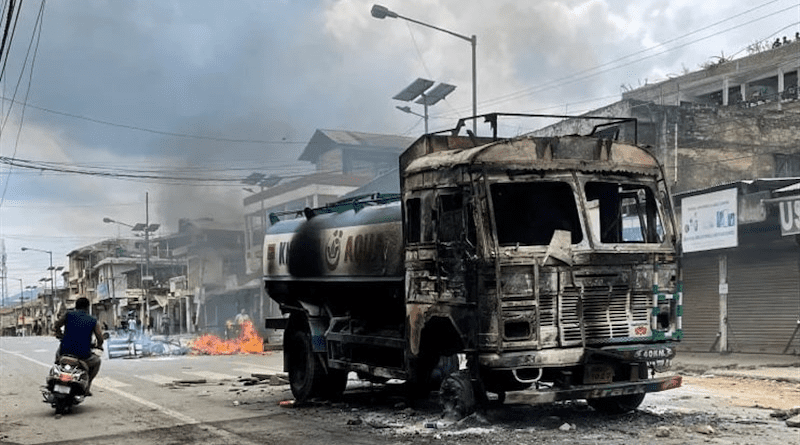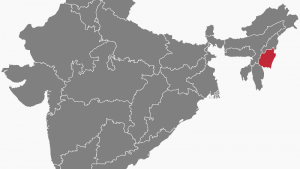India: Roots Of Continued Unrest In Eastern State Of Manipur – Analysis
The North Eastern Indian State of Manipur, which has been experiencing unprecedented civil strife for weeks now, has actually been in continuous turmoil since the State joined the Indian Union in 1949.
This is due to several factors, among which are the following:-
Meitei ethno-nationalism and its clash with tribal groups such as the Nagas and the Kukis; the Central Indian government’s failure to form a manageable territorial unit encompassing diverse ethnic groups; divisive electoral politics; and above all, the Central government’s reliance on draconian instruments like the Armed Forces Special Powers Act of 1958 (AFSPA) to maintain law and order.
The accession of the princely State of Manipur to India in 1949 was itself controversial. The conditions under which the local ruler decided to merge the principality with India had not found favor with some.
In 2019, two Manipur-based umbrella extremist organizations – the Coordination Committee (CorCom) and the Alliance of Socialist Unity, Kangleipak (ASUK) – and the Tripura-based National Liberation Front of Twipra (NLFT) had announced a shutdown to mark the “forced merger” of the two States with India on October 15, 1949. The shutdown affected six districts in the plains of Manipur dominated by the Meitei community. The impact was minimal in the hills dominated by the Kukis.
A joint statement signed by the leaders of the outfits such as NLFT president H. Uastwng Borok and ASUK chairman N. Oken said that the 1949 merger was a “dark period” in the history of Manipur and Tripura. “We have become demographically outnumbered or nearly outnumbered, politically marginalized and disintegrated, economically dependent and pauperized, socially disorganized and splintered. National doom is staring at us viciously. Merger with India is the root-cause of all these national maladies,” they said.
Though the anti-merger agitation fizzled out, multi-ethnic Manipur was faced with the Nagas’ demand for independence and their subsequent demand for the formation of “Nagalim” incorporating all the Naga-inhabited areas in the North-East. The Nagas, who have a home for themselves, in Nagaland, are quite numerous in Manipur also.
Then the Kukis and the Meiteis clashed over land, political power and access to governmental benefits in terms of jobs and educational facilities.
Manipur’s conflicts routinely led to violence which was put down with the AFSP Act that allowed arrest without warrant and also detention for long periods. The relentless use of AFSPA has itself been a major cause of alienation against the State, and that, across the ethnic divide.
Electoral politics have also been an important cause of unrest. The Bharatiya Janata Party’s Hindu nationalist agenda, its inability to chalk up coherent schemes to address competing ethnic issues, and its security-centered approach have alienated all the ethnic groups.
Having won the 2022 State Assembly elections, mainly with the support of the Meiteis, who are high caste Hindus, the BJP yielded to that community’s questionable demand for Scheduled Tribe status, ignoring the pleas of the Kukis who are genuinely tribal. The Kukis were sidelined also because they were Christian.
The Kukis, who lived in the hill areas, and had exclusive land rights there as a Scheduled Tribe, feared Meitei encroachment on their lands if the Meiteis got Scheduled Tribe status.
The Meiteis, on the other hand, argued that they had been treated as a Tribe by the British rulers before the merger of the State with the Indian Union in 1949.
The Hindu-nationalist BJP government in Manipur and the Centre favored the grant of Scheduled Tribe status to the Meities because they were in a majority and had also supported the BJP in the 2022 Manipur State Assembly elections.
With the State High Court also ordering the grant of tribal status to the Meiteis, the State government was poised to implement the proposal when all hell broke loose. The Kukis went on a rampage and the Meiteis replied in kind. More than eighty died, more than a 1000 were injured and tens of thousands were displaced in the clashes.
While the Meiteis complained of inaction on the part of the army and the police and sought direct-rule by the BJP government at the Centre, the Kukis complained of brutal suppression by the forces and a biased State apparatus.
Indian Home Minister Amit Shah flew to Manipur to restore law and order and announced an inquiry that would be completed in six months. But the Meiteis demanded that an interim report be submitted within a month. The Central government however is not in a hurry as it would like the situation to calm down so that it gets enough time to take decisions that would not adversely affect its political prospects in Manipur.
International Dimension
The Centre and the Meiteis are also trying to give the unrest an international dimension by saying that the Kukis have been getting arms from kindred tribes across the border in Myanmar. These Myanarese tribes have been fighting for independence from Buddhist-dominated Myanmar.
Increased fighting in Myanmar had led to the tribes of North Myanmar fleeing to the Kuki hills in Manipur. While the Kukis have extended their traditional tribal hospitality to these refugees, the Meities, the Meitei-dominated Manipur government and the BJP government at the Centre, have been very wary about such infiltration.
Since the Kukis have been cultivating poppy traditionally, trade in poppy has had a significant place in cross-border interaction, raising the hackles in New Delhi. New Delhi’s kinetic action to stop questionable or supposedly questionable cross border trade and people’s movement are resented by the Kukis.
Earlier on, the peace pact between the rebel Nagas and the Central government had resulted in the free movement of Nagas in Manipur, as the State has a Naga population with a place in its politics too. But the Meiteis and Kukis have resented the free movement of the Nagas in their midst.
The unrest and violence in Manipur do not lend themselves to easy solutions as the underlying issues are many and deep-rooted.
There is a demand for direct rule from New Delhi. But this can only provide temporary relief. Sooner or later, ideally, sooner rather than later, Manipur will have to be self-governing as this far off border State cannot be administered from distant New Delhi.
Be that as it may, the authorities in New Delhi and Manipur will have to find solutions to the challenges posed by ethnic and religious diversity and competing demands on scarce resources.
The Kukis have demanded a separate State or an autonomous Union Territory status, but the Meiteis would not countenance a territorial reduction of their State. The move to dismember Manipur could also re-ignite the Nagas’ movement for a unified ‘Nagalim’ uniting the Naga-populated parts of Manipur and other North-Eastern States. Some commentators have suggested an autonomous regional council for the Kuki-dominated parts of Manipur.
Competition for scarce resources, which is one of the reasons for the unrest, is due to Manipur’s underdevelopment. Successive governments in Imphal and New Delhi, and political parties across the board, have made Manipur a market for goods made outside the State and not a production centre. This has resulted in local unemployment and disquiet among the youth across the ethnic divide. The economic problem cannot be overlooked in any search for a long-term solution to the Manipur imbroglio.


